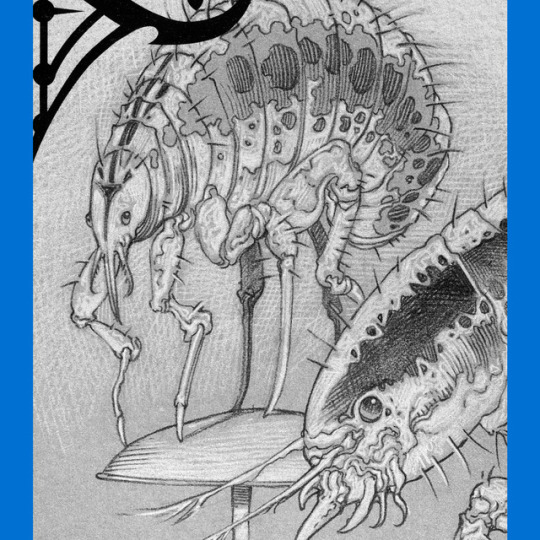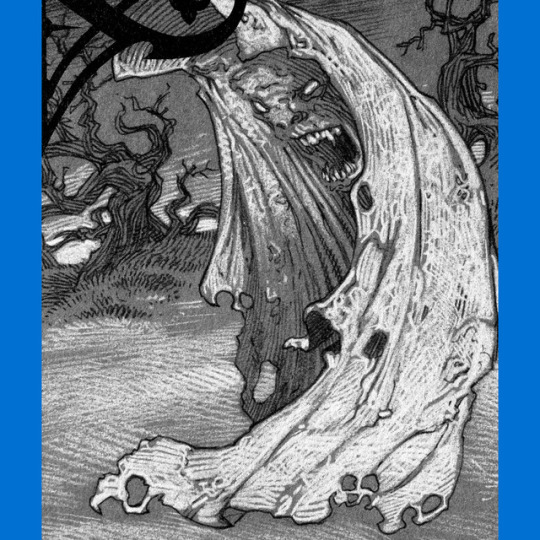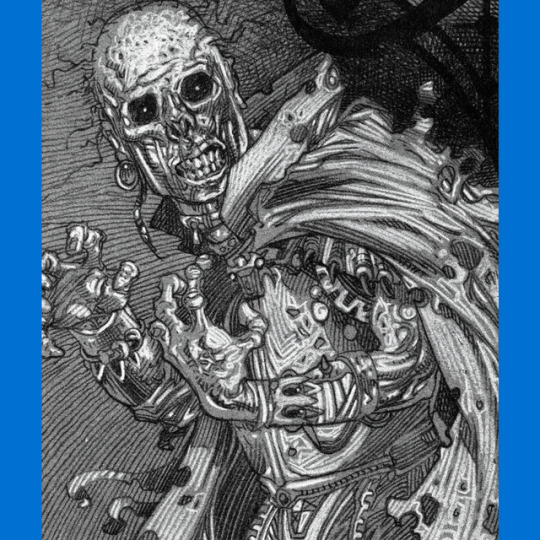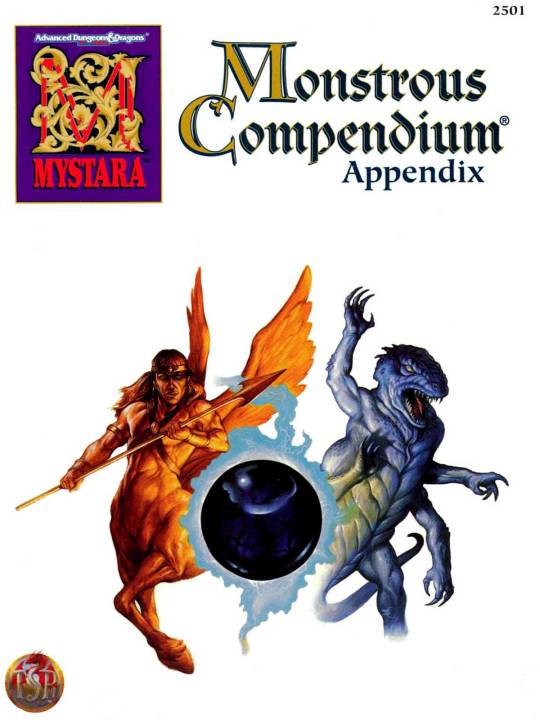#Mystara Monstrous Compendium Appendix
Explore tagged Tumblr posts
Text

"Thouls are magical crosses between ghouls, hobgoblins, and trolls. In spite of their ghoulish blood, they are living creatures, not undead." Most thouls resemble hobgoblins and often live among them, serving as guards to hobgoblin kings and chieftains. They have a paralyzing touch like ghouls and a regeneration ability like trolls. (Arnie Swekel, Mystara Monstrous Compendium Appendix for AD&D 2e, TSR, 1994)
The thoul was mentioned in some printings of the OD&D box, but did not receive full stats until Moldvay's 1981 Basic D&D rules. It has appeared only occasionally in some later editions.
#D&D#Dungeons & Dragons#Arnie Swekel#thoul#Mystara#dnd#Mystara Monstrous Compendium Appendix#AD&D 2e#D&D 2e#hobgoblin#TSR#Dungeons and Dragons
102 notes
·
View notes
Photo





The third Ravenloft Monstrous Compendium appendix was the opposite of the Mystara book for me. It is gorgeous and straightforward – Mark Nelson’s art rivals Stephen Fabian in capturing the mood of the campaign setting. Like all the Ravenloft appendices, this one largely focuses on making horrored-up versions of conventional D&D monsters. Unlike the previous two collections, though, I like these a lot. They feel more thought out somehow.
Thing is, I could never figure out how to use them. They all feel so specific in application, and the opportunity has never come up. One exception: Fleas of Madness. That’s a good story, too, but I am going to save it for when I make a zine out of that adventure…
#D&D#AD&D#advanced dungeons & dragons#dungeons & dragons#TSR#RPG#Tabletop RPG#roleplaying game#roleplaying games#Ravenloft#Stephen Fabian#Mark Nelson#Mystara#Horror#Fleas of Madness
55 notes
·
View notes
Text
Nemhain
Named after an Irish war goddess, the nemhain (pronounced “NAY-wuhn,” because Irish spelling is the world’s greatest exercise in trolling) is an undead creature who is interesting on a number of levels:
1) The nemhain chose to become undead—Bestiary 5 says “as a means of protecting a person, object, place, or ideal.” That’s automatically interesting to me—committing yourself (and your loved ones; see below) to eternal unlife to protect something is devotion/fanaticism on a grand scale. You don't do that just to guard treasure in a 10’x10’ room…but you might for a holy (or unholy) relic, a political movement, a beloved hero, etc. Every nemhain once made a choice, and that means every nemhain has a story…perhaps one that your PCs would be wise to ferret out.
2) The nemhain is surrounded by a cloud of bound spirits—usually the spirits of her relatives or friends. I love this because it recalls one of my favorite undead of all time, the gray philosopher (from the Creature Catalogue and the Monstrous Compendium: Mystara Appendix), whose malevolent thoughts took shape as wispy spirits called malices. I also love it for the pure horror of this scenario—B5 makes it clear that these souls were usually unaware that they would be drawn into the nemhain-to-be’s self-sacrifice. It’s one thing to consign yourself to eternity; it’s quite another to bring the local PTA along with you. And speaking of which…
3) Some nemhains start out good—but they all become evil. No matter how pure a nemhain-to-be’s motives, the vileness of undeath and the violation inherent in harvesting the souls of her loved ones seals her fate. So the nemhain is at best a tragic figure whose single-mindedness damned both herself and those around her. At worst, she’s an abomination willing to sacrifice anything—and anyone—to her cause.
All in all then, every nemhain is special, every nemhain has an interesting story, and every nemhain is deadly (CR 15) at the gaming table.
The pride of elves is dangerous indeed. When a wild elf soothsayer foretold that the Rose Chamber would be claimed by the dead, the grey elf princess Dharotea swore it should never come to pass. She promptly closed the borders to the human mage-scholars, the halfling river traders, and especially the dwarf nations and their necromancer-kings. Even as her self-isolated nation suffered, Dharotea, now queen, never wavered—she would protect the capital, the palace, and its glittering Rose Chamber at any cost. Finally, to stave off her own death, she performed the Act of Reaping to become a nemhain…inadvertently slaying the rest of the royal court and fulfilling the vision the soothsayer warned of so long ago.
No one expects a bardic college to be deadly—especially not one famous for its jugglers, tumblers, and acrobats. But the nemhain known as the First Harlequin roams the Laernuin College grounds, and those he selects to perform in his monthly pantomimes must have the ancient forms memorized exactly or be struck down mid-performance.
The worst revolutionaries are the time-traveling ones. After thwarting a dangerous anarchist—a fiendishly charismatic bard with enough alchemy under his belt to be a literal bomb thrower—adventures discover that he has hatched plots in both the future and the past to undo their hard work. Worse yet, defeating the anarchist’s allies in one time period doesn’t always mean they’re off the game board. While in their own time the anarchist’s chief lieutenant, Victoria Graves, is too elderly to do more than fund whisper campaigns against them, in the past she is a dashing vigilante, and in the future she is a nemhain determined to see the Scarlet Revolution come to pass.
—Pathfinder Bestiary 5 182
I’ve always wanted to learn Irish (I’m still in touch with my whatever-cousins-however-removed in Carndonagh) but I’m pretty sure I’m 20 years too late for my brain to expand as far as it needs to. (Hell, I bought a bodhrán in Donegal when I was 17 and I still can't play it, and I’ve been drumming since fourth grade.)
If you’re looking for a fantastic fall-from-grace tale that echoes the nemhain’s, I highly recommend Garth Nix’s Clariel: The Lost Abhorsen, as well as the rest of The Old Kingdom series.
181 notes
·
View notes
Text

Mystara Monstrous Compendium Appendix for AD&D 2e, 1994, Jeff Easley cover art featuring the pegataur, the blackball (an apparently living creature very similar to a sphere of annihilation), and the frost salamander
#D&D#Dungeons & Dragons#Jeff Easley#Mystara#Monstrous Compendium#pegataur#blackball#frost salamander#monster#monsters#Mystara Monstrous Compendium Appendix#dnd#AD&D 2e#Dungeons and Dragons#TSR#1990s#D&D 2e
130 notes
·
View notes